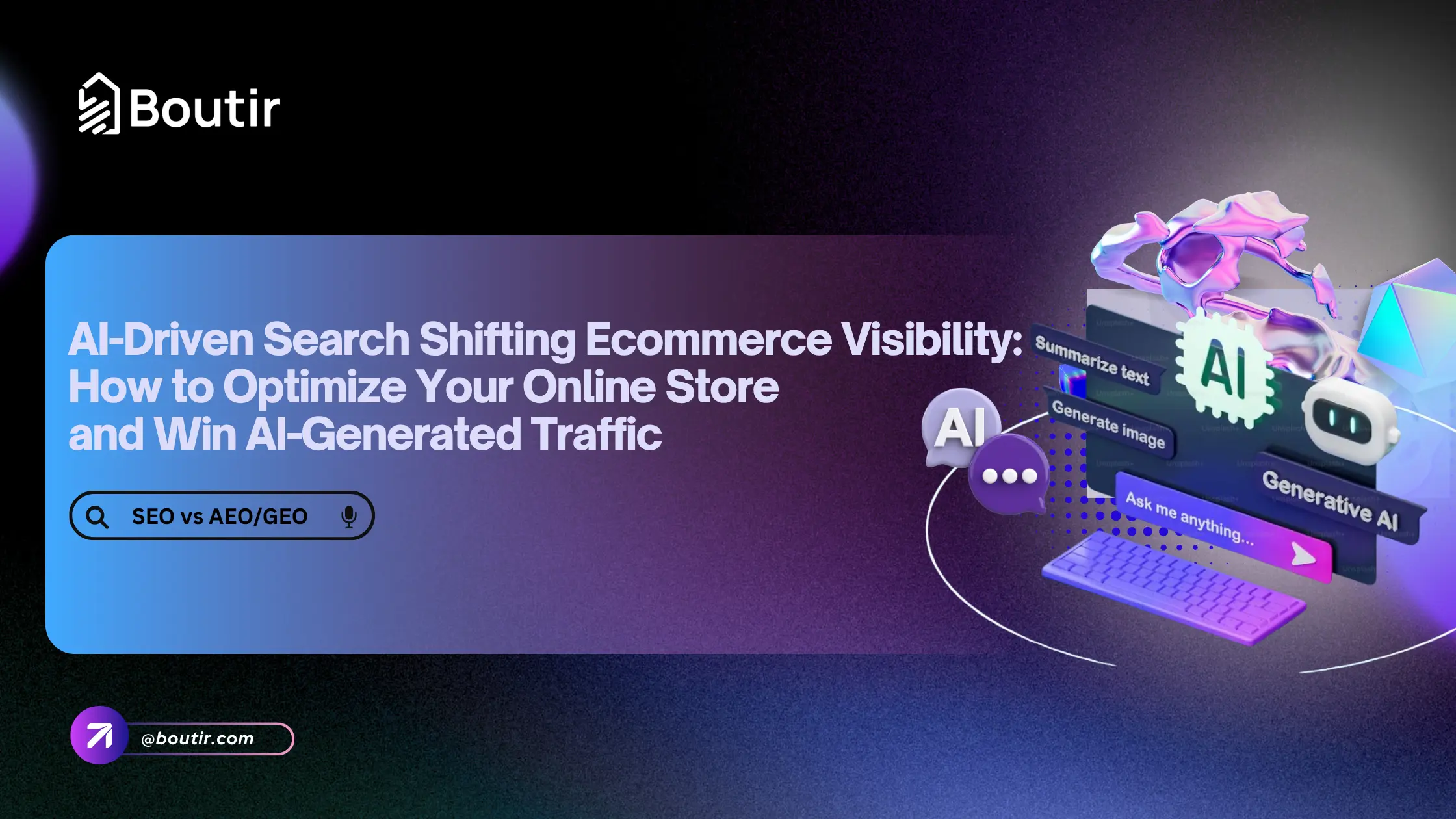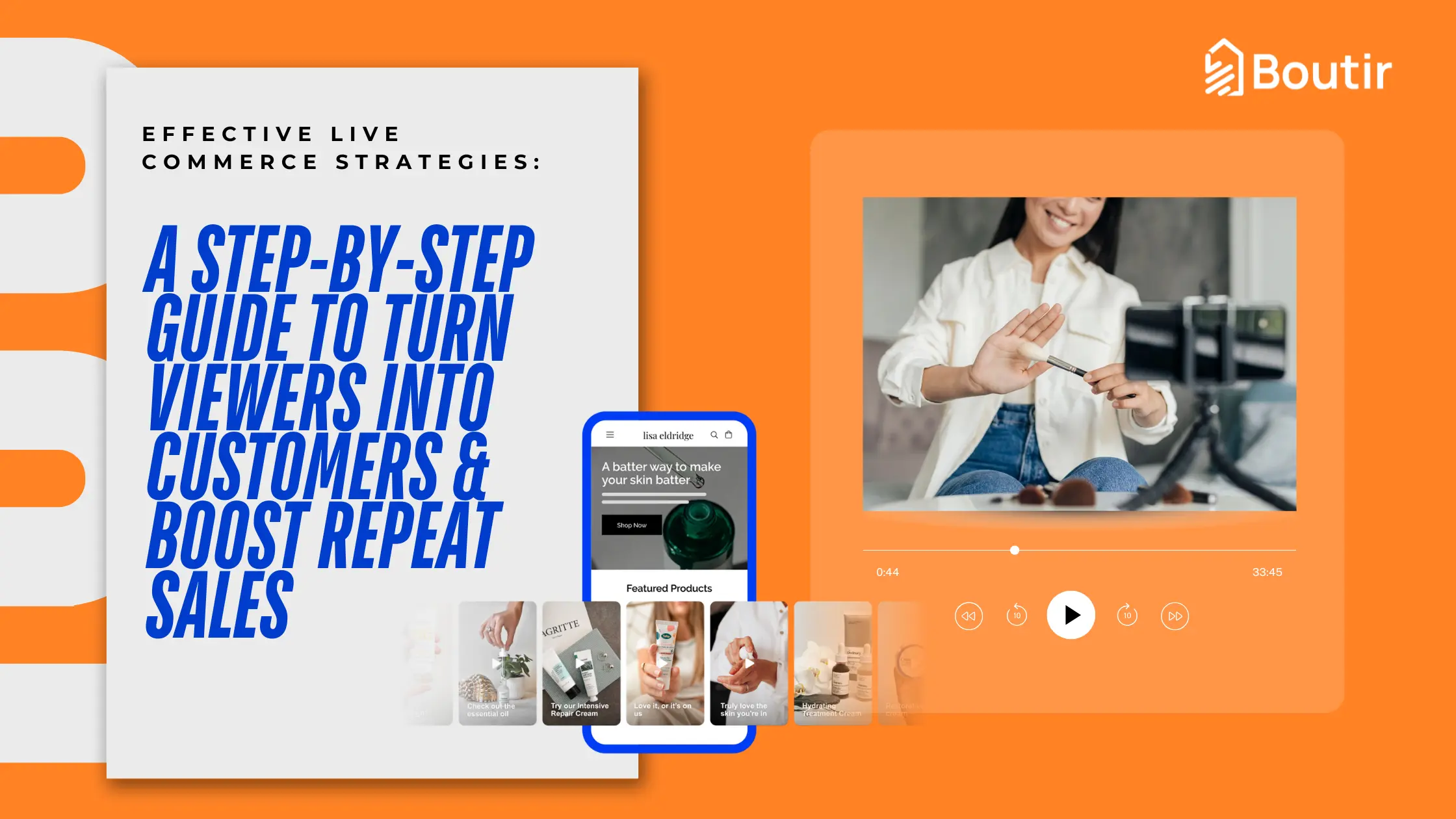The way customers find online stores is changing fast. For years, search engine optimization (SEO) was the backbone of ecommerce visibility, relying on keywords and ranking high in traditional search results. But today, generative AI (think ChatGPT, Google Gemini, or Amazon’s AI recommendations) is rewriting the rulebook.
Semrush predicts that by early 2028, traffic from large language models (LLMs), the tech behind AI search, will surpass traditional organic search traffic. For Boutir merchants, this isn’t just a trend: it’s a make-or-break shift. Adobe Analytics reports that AI-driven traffic to retailer websites jumped 1,200% between July 2024 and February 2025, and during Amazon’s recent Prime Day, that traffic surged 3,300% year-over-year. Even more telling? Accenture found 18% of generative AI users rely on it for purchase recommendations, more than social media, and second only to physical stores.
To stay visible, merchants need to understand two new critical terms: AEO (AI Engine Optimization) and GEO (Generative Engine Optimization). These strategies aren’t replacements for SEO, they’re extensions that align your online store with how customers now search. Below, we break down why AEO/GEO matters, how they differ from traditional SEO, and how to implement them to boost traffic and trust.
Why AEO/GEO Are Non-Negotiable for the Future of Ecommerce
Generative AI isn’t just a “nice-to-have” tool for shoppers, it’s becoming their primary way to discover, research, and buy products. For Boutir merchants, optimizing for AEO/GEO isn’t optional; it’s how you secure your store’s visibility in the AI-driven search era. Here’s why it matters:
AI Is Becoming the “First Stop” for Shoppers: Gone are the days when customers typed a keyword into Google, scrolled through 10+ results, and clicked a link. Today, they ask an AI tool directly: “What’s the best waterproof hiking boot for wide feet under $200?” or “Recommend a sustainable skincare routine for sensitive skin.” If your online store’s content isn’t structured to be pulled into these AI answers, you’ll miss out on a massive, high-intent audience.
Early Adopters Gain a Permanent Edge: Right now, most merchants are still focused on traditional SEO, meaning the field for AEO/GEO is wide open. By optimizing your content for generative engines today, you’ll establish your brand as a trusted source in AI results. As AI search becomes more mainstream, later adopters will struggle to catch up, AI systems prioritize content that’s been consistently optimized for their needs (think: clear, authoritative, and intent-aligned).
AEO/GEO Builds Trust (and Reduces Friction): AI users trust answers that are specific, credible, and tailored to their needs. When your online store’s products, reviews, or guides are featured in AI-generated recommendations, it acts as a third-party endorsement. For example, if Google Gemini suggests your store’s hiking boot with a line like “YOUR BRAND offers a waterproof boot with wide-fit options and 4.8/5 reviews,” customers are more likely to click through and buy, because the AI has already filtered out low-quality options.
It Complements (Don’t Replaces) SEO: AEO/GEO doesn’t mean abandoning traditional SEO. In fact, many AEO/GEO best practices (like clear content structure or EEAT principles) also boost your rankings in traditional search. By optimizing for both, you’ll capture traffic from both AI-driven queries and classic keyword searches, creating a fully resilient visibility strategy.
SEO vs. AEO/GEO: Key Differences (At a Glance)
|
Category
|
Traditional SEO
|
(AI/Generative Engine Optimization)
|
|
Primary Focus
|
Ranking high in organic search results pages (SERPs) for specific keywords.
|
Being featured in AI-generated answers/recommendations (not just SERPs).
|
|
Content Priority
|
Keyword density, meta tags, backlinks, and long-form content (e.g., blog posts).
|
Conversational intent, clear structure (e.g., FAQs, bullet points), and expertise.
|
|
Searcher Behavior Targeted
|
Users who actively browse and click links to find information/products.
|
Users who seek immediate, tailored answers (no browsing required).
|
|
Success Metrics
|
SERP rank, organic click-through rate (CTR), keyword traffic, and backlink count.
|
AI answer inclusion, “click-to-store” rate from AI results, and AI-referred sales.
|
|
Content Structure
|
Flexible (e.g., narrative blog posts, product descriptions with keyword placement).
|
Rigidly clear (e.g., numbered lists, FAQs, explicit use cases) for AI extraction.
|
|
User Intent Focus
|
Broad keyword intent (e.g., “hiking boots” could mean research, comparison, or buy).
|
Hyper-specific, conversational intent (e.g., “wide-fit hiking boots under $200”).
|
|
Tools for Optimization
|
Ahrefs, SEMrush, Google Search Console, Yoast SEO.
|
AI content analyzers (e.g., Frase, Clearscope), Google Bard/Gemini (for testing).
|
How to Optimize Your Online Store for AEO/GEO (Actionable Strategies)
Optimizing for AEO/GEO doesn’t require advanced tech skills, just a shift in how you structure and create content for your Boutir store. Below are the top strategies to implement today, tailored to ecommerce needs:
1. Prioritize Conversational Intent (Not Just Keywords)
AI tools excel at understanding why a user is searching, not just what words they use. For your online store, this means moving beyond keyword stuffing and focusing on personas, use cases, and natural language.
Example: Instead of a product title like “Waterproof Hiking Boot – Black – Size 9,” use “Waterproof Wide-Fit Hiking Boot for Men/Women | Ideal for Rainy Trails | Size 5–13.”
How to apply:
- Write product descriptions that answer common questions: “Is this boot true to size?” (Yes, with a wide toe box for comfort) or “Can it be worn in snow?” (Yes, with a slip-resistant sole).
- Create blog posts that mirror AI queries: Instead of “Best Hiking Boots 2024,” try “What’s the Best Waterproof Hiking Boot for Wide Feet Under $200?”
- Using Boutir’s product tag feature to add intent-based tags (e.g., “wide-fit,” “waterproof,” “under $200”), AI tools scan these tags to match user needs.
2. Double Down on EEAT (Experience, Expertise, Authoritativeness, Trustworthiness)
AI systems prioritize content that’s credible, because their users do. Google, Gemini, and other tools use EEAT principles to filter out low-quality or misleading information. For Boutir merchants, this means proving your store is a trusted source:
- Experience: Highlight real-world use cases. For example, if you sell camping gear, add a section to your store: “Our Team Tested 10 Tents, Here’s Why This One Stood Out in Stormy Weather.”
- Expertise: Feature author bios for blog posts (e.g., “Written by Sarah, our in-house hiking expert with 5+ years of trail testing”). For product pages, include “Why We Recommend This” sections from your team.
- Authoritativeness: Showcase third-party validation. Add badges for certifications (e.g., “Sustainably Sourced – B Corp Certified”) or link to media features (e.g., “As Seen in Outside Magazine”).
- Trustworthiness: Display verified reviews prominently. For example, on your product page, add a snippet like: “4.8/5 from 200+ customers – 90% say it’s ‘true to size.’”
3. Structure Content for AI Extraction (Clear = Catchy)
AI tools can’t “read” messy, unstructured content, they need clear, scannable formats to pull into answers. For your Boutir store, this means simplifying how you present information:
- Add dedicated FAQs to product pages: Use questions that mirror AI queries (e.g., “Does this boot come in wide sizes?” or “How long does shipping take?”).
- Use bullet points and numbered lists: Instead of long paragraphs, break down product benefits or guides into bullet points.
- Label content explicitly: Use headings like “Key Features,” “Who This Is For,” or “How to Use” so AI tools can quickly identify relevant sections. For example, a skincare product page might have a heading: “Who This Serum Is For: Sensitive skin types prone to redness.”
4. Adapt Video Content for AI (It’s Not Just for Viewers)
Video is a goldmine for AEO/GEO, but only if AI tools can understand what’s in it. Most AI systems can’t “watch” videos, but they can read transcripts, titles, and descriptions. For your Boutir store’s product videos or behind-the-scenes content:
- Optimize video titles/descriptions for intent: Instead of “Hiking Boot Demo,” use “How to Test if a Hiking Boot Is Waterproof (X Brand Review).” This helps AI tools match the video to user queries like “How do I know if a hiking boot is waterproof?”
- Use Boutir’s video SEO tools: Add alt text, titles, and tags to product videos, fill these out with intent-based language (e.g., “waterproof hiking boot demo for wide feet”).
5. Seed Your Brand Across Trusted Platforms (AI Loves “Social Proof”)
AI tools pull content from across the web to build answers, so the more your Boutir store is featured on credible sites, the more likely it is to appear in AI results. This is called “brand seeding,” and it’s critical for AEO/GEO:
- List your store on trusted directories: Sites like Google Business Profile, or industry-specific directories (e.g., Outdoor Gear Lab for camping gear) add credibility. Make sure your store’s name, address, and product focus are consistent across all listings.
- Partner with micro-influencers for reviews: Ask influencers in your niche to review your products on their blogs or social media. AI tools scan these reviews for social proof, if an influencer says, “This store’s skincare line cleared my acne,” it may be featured in AI answers about “acne-friendly skincare.”
6. Test Your Content with AI Tools (See How It Performs)
The best way to refine your AEO/GEO strategy is to “test” your content in the tools your customers use. Try these quick checks:
- Ask Google Gemini/chatGPT about your niche: Type a query like “Best sustainable skincare”, does your store or products get mentioned? If not, adjust your content to match the keywords/structure of the answers that are featured.
- Use AI content analyzers: Tools like Frase or Clearscope scan your product pages and grade them for AEO/GEO readiness. They’ll flag issues like “lack of FAQs” or “vague product descriptions” and suggest fixes.
The future of ecommerce visibility is AI-driven, and AEO/GEO is your ticket to staying ahead. By aligning your online store with how customers now search, you’ll not only drive more traffic, you’ll build a brand that’s trusted, resilient, and ready for whatever the next search shift brings.
Start Selling With Boutir Today!
Got Questions? Speak to one of our sales consultants.
FB Messenger / WhatsApp / Email
Service Hour:
- Monday to Friday:10:00 – 23:00
- Saturday, Sunday and Public Holiday:12:00 – 18:00





